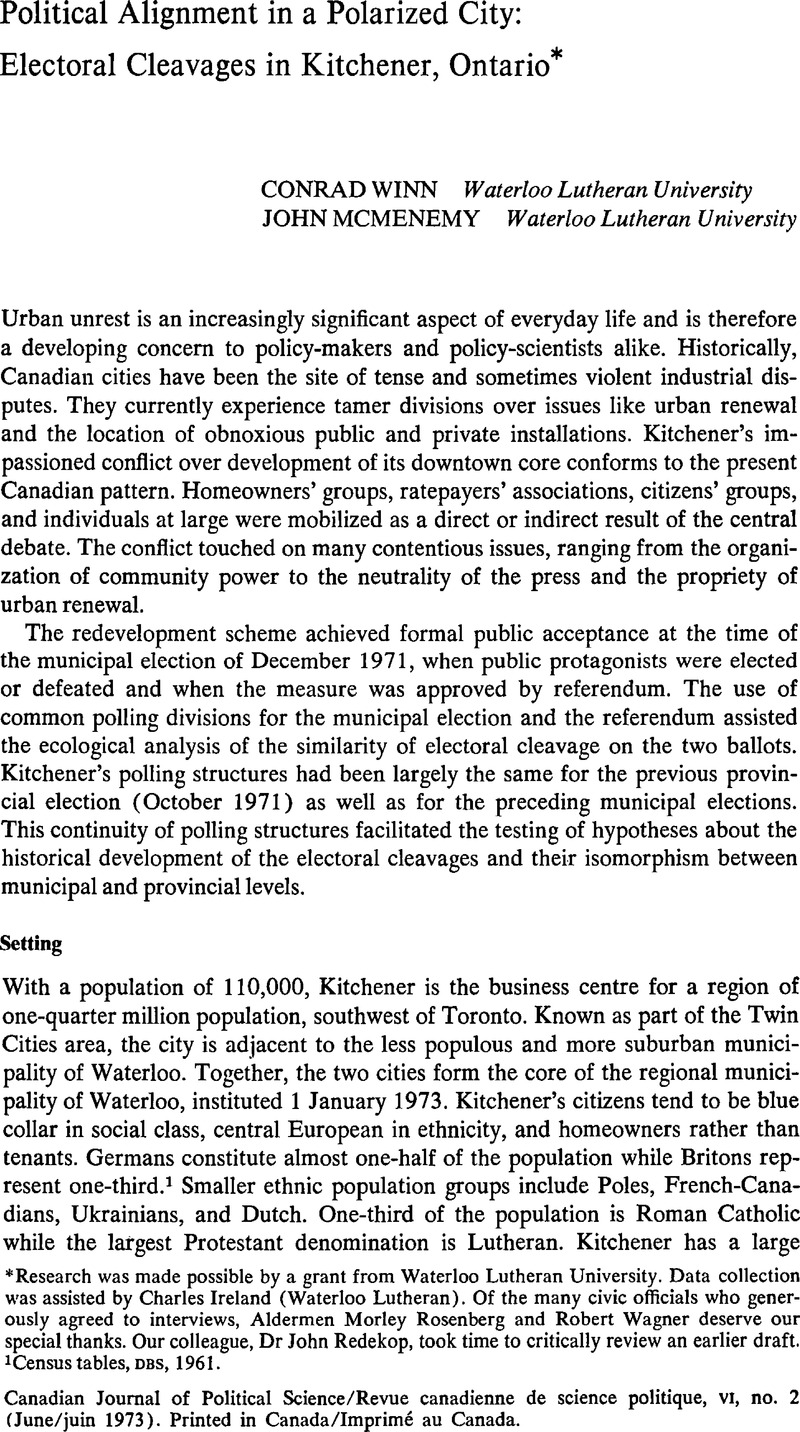Article contents
Political Alignment in a Polarized City: Electoral Cleavages in Kitchener, Ontario*
Published online by Cambridge University Press: 10 November 2009
Abstract

- Type
- Articles
- Information
- Canadian Journal of Political Science/Revue canadienne de science politique , Volume 6 , Issue 2 , June 1973 , pp. 230 - 242
- Copyright
- Copyright © Canadian Political Science Association (l'Association canadienne de science politique) and/et la Société québécoise de science politique 1973
References
1 Census tables, DBS, 1961.
2 The urban national average refers to the mean for a sample of cities selected by the Department of National Revenue in Taxation Statistics (Ottawa: Queen's Printer, 1970)Google Scholar, Summary Table 1.
3 Alderman Morley Rosenberg, interview, April 1972. For a study of party alignment in municipal legislative behaviour, see Kay, Barry J., “Voting Patterns in a Non-partisan Legislature: A Study of Toronto City Council,” this Journal, IV (June 1971) 224–42.Google Scholar
4 The farmers’ market is associated in the public mind with the old order Mennonite community of Waterloo County. For a popular account of the market prior to the development, see Staebler, Edna, “Why gourmets flock to Kitchener's wonderful Mennonite Market,” Maclean's, 4 September 1965, 15–17, 38–9.Google Scholar
5 The Ontario Municipal Board was created by the provincial government to oversee such municipal matters as debenture issues, zoning, annexation, and amalgamation. Its rulings may be appealed to the courts and the provincial cabinet. See Feldman, Lionel D., “Legislative Control of Municipalities in Ontario,” Canadian Public Administration, IV (1961) 296–9.Google Scholar
6 In the referendum, the “yes” proportion was 56.7 per cent, the “no”, 43.3 per cent. Slightly more than 40 per cent of eligible voters cast ballots. In 1967 and 1969, 38 per cent and 27 per cent of the electorate voted. The low 1969 turnout is commonly attributed to the absence of a mayoral contest while the high 1967 vote is attributed to a close mayoral race. In 1971, the mayoral contest was noncompetitive, with the incumbent receiving four-fifths of the vote. The high 1971 turnout may therefore be attributed to the market crisis itself.
7 Winsor, Hugh, “A Power Elite Gets its Way in Kitchener,” Globe and Mail, 7, 8 February, 1972.Google Scholar
8 For detailed elaboration, see ibid.
9 Newman, Peter C., “The View from Here,” Maclean's, June, 1972, 3.Google Scholar See also Senator Keith Davey, “How the Media Withheld the Message in Kitchener,” ibid.
10 Winsor, “A Power Elite.”
11 Ibid.
12 First you need some muck,” editorial, Kitchener-Waterloo Record, 9 February, 1972. The editorial was a response to Winsor's articles, particularly his “Viewpoint,” (8 February), and to the Globe and Mail editorial, “The citizens’ right to know,” also published 8 February, 1972.
13 For a classic statement on the instability and obscurity of public opinion, see Converse, Philip E., “The Nature of Belief Systems in Mass Publics,” in Ideology and Discontent, ed. Apter, David E., (New York, 1964).Google Scholar
14 Winn, , “Spatial Models of Party Systems: An Examination of the Canadian Case,” doctoral dissertation, University of Pennsylvania, 1972.Google Scholar
15 Community Conflict (Glencoe, Ill., 1957). See also Banfield, Edward C. and Wilson, James Q., City Politics (Cambridge, Mass., 1967)Google Scholar, especially 35–46.
16 “The Insulation of Local Politics Under the Nonpartisan Ballot,” American Political Science Review, LIII (Demember 1959), 1052–63.
17 Ibid.
18 See Rummel, R.J., Applied Factor Analysis (Evanston, Ill., 1970), 104–12Google Scholar and passim.
19 The association matrix consisted of product moment correlations; the communality estimates were SMC's; and the rotation criterion was eigenvalue one. The actual program was BMDO3M, performed at the computer centre of the University of Waterloo.
20 See Appendix for a list of aldermen and their party and religious affiliations.
21 Interview, April 1972.
22 In 1972 McLennan was an unsuccessful candidate for the federal Progressive Conservative nomination in Kitchener.
23 An anonymous source in the Kitchener Liberal Association.
24 See Table II, factor II.
25 See Table II, factor IV. Alderman Wagner is identified as an Independent Liberal because his real partisan affiliation is not widely known and because, by his own admission, his partisanship is not fierce. One fellow alderman is certain that Wagner is a Conservative.
26 In 1967 McLennan and Chapman were the only candidates for mayor; therefore, their loadings are similar except that the signs are opposite.
27 The assistance of Jennifer Uttley, Computer Centre, University of Waterloo, and Bill and Janet Ableson, then in the Department of Statistics, University of Waterloo, is gratefully acknowledged.
28 See Cooley, William W. and Lohnes, Paul R., Multivariate Data Analysis (Toronto, 1971)Google Scholar, chap. 6, and Morrison, Donald F., Multivariate Statistical Methods (Toronto, 1967)Google Scholar, chap. 6.
29 The computer program was BMDO6M. See Dixon, W.J., BMD-Biomedical Computer Programs (Berkeley and Los Angeles, 1967).Google Scholar
30 Of course the correlation value is dependent on the particular coefficients associated with each variable in each set. Interested readers may write the authors for a copy of the output.
31 Honsberger's well-known family lumberyard is in the Northwest, MacIntosh's residence, in the Southeast.
32 “The Insulation of Local Politics.”
33 The provincial results were Breithaupt, Liberal (42.2 per cent), MacIntosh, Progressive Conservative (29.8 per cent), Mitchell, NDP (27.0 per cent).
- 3
- Cited by




